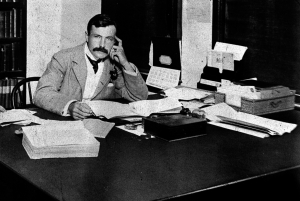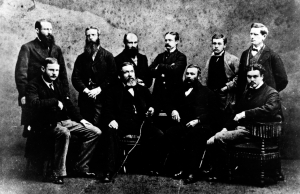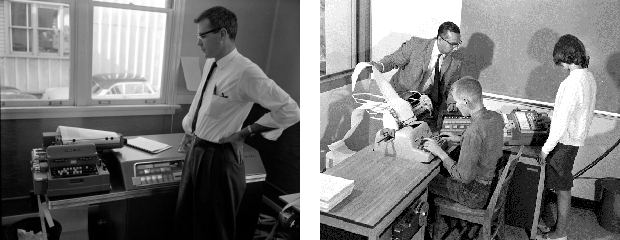by Derek Swallow
Innovation in such areas as exhibition methodology, education programs, revenue generation is expected in the 21st Century museums. This is not always the case for core museum processes. However, necessity can drive such innovation. Many twenty-first century museums face the harsh reality of shrinking budgets. One impact: fewer staff with heavy workloads. To maintain high service standards and internal best practices museum personnel look for ways to work more efficiently. Better time management is one solution. New measures such as pruning the number and length of meetings can conserve this now precious commodity – time. Modifying the delivery and structure of tradition museum business meetings is an area where savings can be found. In early 2013, the Royal BC Museum, where I work, launched a pilot project, aimed simultaneously at carving down our collections committee meeting time and building a more flexible, egalitarian process.

# f 08817 Collection of the Royal BC Museum/BC Archives.
Traditionally, our committee composed of curators, archivists and a conservation representative, guided by a chair person, met monthly for one and a half hours: its mandate to decide which new collections, proposed by discipline curators or archivists, would be accepted into the Royal BC Museum permanent holdings as well as adjudicate recommended collection deaccessions. The agenda, provided electronically to members several days before the meeting allowed time to digest the information about each proposed acquisition including the proponent curator’s acquisition proposal (rationale for acquisition) and the conservation department report. The latter included the general to specific condition of the collection and its components, specifying the time needed to both stabilize and preserve these components over the long term. Armed with this data the members of the collections committee, along with the curator/archivist proponent for each collection, attended the monthly meeting. The proponents “presented” their collections, fielded questions, then the committee would vote. Proposed deaccessions were handled in a similar manner. I suspect this is a familiar format for many of your institutions.
# a 00514 Collection of the Royal BC Museum/BC Archives.
Along with the process the committee structure changed. An egalitarian measure was built in: members now included collections managers as well as curators and archivists. The registrar, previously the recording secretary, assumed the role of quasi-chair person responsible for creating and updating the electronic voting agenda, and the capture and dissemination of electronic communication.
In brief, this is how the “virtual” collection committee (CC) works:
Once a collection has a completed acquisition proposal entered into our database by the proponent curator or archivist, conservator and discipline collections manager the registrar posts it to the excel spreadsheet “voting list”, serving as an agenda. The contained fields include the discipline of the collection, registration number (unique number created by our collections management system), the name of the donor or collection, a summary description, the name of the collection proponent, and voting boxes for each committee member. This spreadsheet, posted at the beginning of a month, to a common drive, is accessible to CC members. If a CC member has a question about a given collection this is sent via email to the proponent cc’ing all the other CC members. The response is therefore sent back to the committee as a whole. This replaces in-person discussions regarding the collections. The registrar copies all such questions and answers, as well as general CC member comments, pastes them into a Word document which forms which, along with the voting list/agenda forms part of the permanent record of decision.

# na 19565 and # i 24586-1 Collection of the Royal BC Museum/BC Archives.
The voting list/agenda is a “living” document; as collections are readied for review they are added by the registrar for the first three weeks of the month, where after, the agenda is closed and the registrar tallies and posts the results.
Advantages of the new model include the following:
- Voting is flexible – can be done when time permits
- The process is Greener – no paper is involved
- Collection advocate responses to CC member questions can be thought out and clearly presented – rather than being “off the cuff” in a regular meeting. In addition these questions and answers can be saved in whole. I traditional meetings the minutes contain only a synopsis of the discussions. Some subtle and compelled points may accidentally be omitted.
- There are no minutes to write up.
- Time for travel between offices and the meeting room is saved as well as wasted time waiting for a meeting to start as well as through social engagement during and after the meeting. This easily amounts to an hour savings in itself.
Disadvantages of the new model include the following:
- Using only email communication reduces the dialogue related to each acquisition and there can be more communication in less time in a face to face meeting.
- Important opportunities to discuss important spin off issues that arise from collections discussion such as policy and procedures are lost.
- Some members find the depersonalization of the process discomforting – we need to come together face-to-face as a group.
- Since voting is done in a staggered manner there is a possibility a CC member may be influenced by viewing the vote of a respected colleague.
- Registrars tracking time is greater.
I am the first to admit, as designer of the system, that the net time savings is relatively nominal. However, a gain of an hour and a half a month is helpful and if others look at internal processes with the same view of saving an hour or so a month soon we have an addition day of time savings. Unfortunately, this doesn’t reduce our workload and give us more free time, it simple means we don’t have to work so onerously hard tackling this workload.
I end with a quote from the famous mid-twentieth century American actor and radio announcer Edgar Bergen: “Hard work never killed anybody, but why take a chance.”
This post is also available in Italian, translated by Marzia Loddo.
Thanks, Derek – an interesting experiment, and one which I’ll share with my colleagues and bear in mind as we review our acquisition procedures at the Horniman Museum. Although only quarterly, our meetings can be very long – sometimes well over two hours.